A Canadian krimie from the Sunshine coast of British Columbia on the eastern shore of the Strait of Georgia and just northwest of Vancouver, though populous and favoured by tourists, it can only be reached by ferry. Ergo it is somewhat remote.

Because of the mild climate, it is also favoured by retirees. In this story two brothers-in-law figure, both in their 80s. After a lifetime of putting up with each other, one kills the other. Ah, all those family Thanksgivings and Christmases are enough to drive anyone to extremes. Though here the palette is darker still. The deed is done.
The perpetrator prepares to face the police, but when the Mounties come to get their man, they ignore this frail old man in favour of suspicious types who may have been seen around. That is a nice set up. Once he has been passed over, the perpetrator decides to let it be. He does not blurt out the confession he had rehearsed but goes coy and vague. That of course, in time, makes the Mountie, Karl Alberg, who sticks with the case, suspicious.
Alberg finds the time to romance the local librarian, Cassandra, but neither of them seems very good at romance. The villain is a library user and their paths cross.
Along the way we find out more about the Mountie, who never wears the uniform, and the librarian, and Gibsons, the town. There is much gardening, I suppose because it rains so much there, as in Rain City, Vancouver.
I am not whether this is part of series. Nothing is said on the cover.
 L. R. Wright
L. R. Wright
L.R. Wright has a number of titles, and perhaps I will try another.
Category: Krimi
Raymond Chandler, ‘The Killer in the Rain’ an Audible Book read by Elliot Gould.
While travelling I went looking for Chandler’s ‘The Lady in the Lake’ on Audible to test Jacques Barzun contention that it is the best of Chandler’s many good novels, but all I could find was a cut down dramatised version. I did listen to that and it had the essence of the plot but not enough of the prose. I also noticed ‘The Killer in the Rain’ and took it, too. This was a reading not an enactment.
‘The Killer in the Rain’ is a collection of early short stories by Chandler which, in this version, includes:
‘Killer in the Rain’
‘Goldfish’
‘Finger Man’
‘The Curtain’
Having read the complete Chandler oeuvre, I have read these stories but have not thought of them for years. Time to re-new our acquaintance.
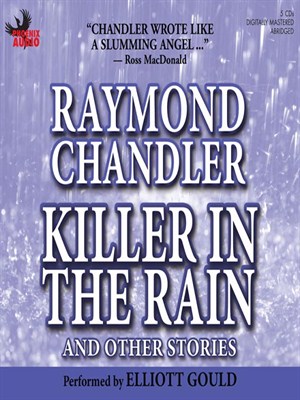
Two things emerged. First, I heard characters, incidents, events, situations that Chandler re-worked later in his novels. It was interesting to realise that good as the stories were, they were improved when he re-worked them into the novels. Though there also people and events in the stories that did not make it to the novels, some pretty arresting ones, especially those goldfish and the small woman with the big gun.
Second, Elliot Gould was all wrong for this assignment. He just does not sound like California. He lacks the laconic sunshine in his voice of, say, Dick Powell, Robert Montgomery, James Garner, or Powers Boothe, all of whom have had a turn at Marlowe. Yes, I know Humphrey Bogart was also a New Yorker but he did not sound it the way Gould does. Now perhaps it is because I know who Gould is that I say that. But while I am saying it I will add that he sounds like a New Yorker.
His diction is perfect; he does well in distinguishing the voices of all the characters, yet I quibble.
There is more, perhaps I was also distracted because I know why he got the assignment. He played Marlow in a Robert Altman film ‘The Long Goodbye’ in 1973 derived from Chandler’s novel of the same name. And that is my point, because that film was a parody of Marlowe. Its expressed purpose was to show how inept and unsuited such a figure as Marlowe was in the real word of crime and corruption.
To return to my theme. Gould’s claim to the job is that he was the anti-Marlowe. That niggled me, too. That made two strikes against it. I cringed at his New York voice and I just knew he had no sympathy for the character he was projecting. Had he any sympathy he would never have done the Altman film!
There are dozens of alternatives to listen to on my iPhone but I stuck out ‘The Killer in the Rain’ to the end. Why? Chandler’s prose.
 Raymond Chandler
Raymond Chandler
That man could turn a phrase, spin a metaphor, bite off a line, all in the warm California sunshine he could present a very dark, very black world.
The bad news is that Gould is the reader for most of the Chandler titles on Audible.
I discovered Audible Books with my first smartphone, a Samsung, and liked the idea. At that time I walked the honourable dog several mornings a week and sometimes in the afternoon, too. Kate and I were both working and we took turns. When on dog walking duty I listened to talking books.
I was familiar with talking books on CDs and had listened to many on drives in the States, including much Marcel Proust. Those titles were all books that had been produced for voice. With Audible I also discovered books that were only Voice Books, just as there are books that are only Electronic books, v-books and e-books. The first v-book I heard was a freebie from Audible, that must have been the business model to lure in customers, about letters to Sherlock Holmes’s address. It was a nice idea for a set up. I joined Audible and continue to subscribe.
Helene Tursten, ‘The Fire Dancer’ (2005)
A Swedish krimie in a series featuring the insightful Inspector Irene Huss. These are police procedurals of a high order. This is the second Huss novel I have read. Evidence is compiled and interpreted, witnesses are questioned repeatedly, and finally Huss sees something in it. The locale is well realised, as are the manners and morēs of contemporary Sweden in Göteborg, along with the weather.

This story revolves around arson and spans 15 years. Huss makes several mistakes but admits it and continues. She has grit, that is for sure. The Fire Dance of the title is very nicely done and makes sense.
Huss, when not pursing murderers, copes with two teenage daughters who are fast outgrowing her influence. Her husband works as many nights as she does and that makes things difficult, despite the abundant good will of all parties. He is a chef in a restaurant.
That is the molasses, and here is the vinegar.
There are far too many distractions, most of which do not develop either plot or character. There are repeated descriptions of rooms and clothes that contribute zero to the story. Yet in contrast, Angelika, a principal character, is left practically a cartoon figure there to be stupid, vain, and just get in the way, not a human being at all, but an annoying plot device.
In reality police work on many cases at once, true, but in this novel there is a second plot that occupies a quarter of the book and contributes nothing to the main story line. Art must reflect life, yes, but it need not repeat it word-for-word.
If the superfluous description were substantially reduced and the secondary plot truncated to an aside the book would shed 100 pages, and increase the likelihood that a reader will finish it. When an author spends so much space on descriptions and the secondary plot, readers begin to think that they somehow will play into the resolution. That is the contract between krimie writers and krimie readers: If it is there, then it is relevant in the end. Not so here. This contract goes double for procedurals which this title certainly is.
Huss’s home life is well handled but there is just too much of it. The husband’s collapse seems contrived and is wholly irrelevant. Yes, I know, life is like that, but this book is not life, it is art.
Finally, I just did not get the motivation of the villain. It did not register, just voilà, he did it. Why?
I felt very early that Huss jumped to the conclusion without any evidence that the victim had been held prisoner, when, especially given how strange the victim was, she just might have gone off on her own. Of course that is what happened but it seemed like Huss had read the book and knew the future! Equally, the initial description of the victim as icy and remote does not payoff. It is there, it seems significant, it is well written, and, it is irrelevant.

Donna Leon, ‘By its Cover’ (2014)
Commissario Guido Brunetti remains in top form. Age has not wearied Donna Leon. The prose is crisp, the place evoked, the people differentiated, the ear for dialogue is pitch perfect, including that all important element of many conversations — what is not said.

This adventure takes Brunetti into the world of rare books when thefts from a specialist library come to light. To understand better this strange new world he seeks advice from friends of friends and others among the many strata and castes of contemporary Venice. Though the impact of tourism is mentioned Leon does not, in this book, dwell on it, perhaps remembering that those tourist dollars keep Venice afloat on its lagoon, much more so that any support from the government in distant Rome.
Brunetti’s home life is evident but treated with a light and sure touch. Though we learn about some of his meals, the pitiless descriptions that populate some, many tiresome krimies is avoided. Likewise she seldom if ever describes clothing or even people. The exceptions to this lack of description are well judged to bring out a person’s character, not an automatic gurgitation to fill space that is so common in lesser works.
Once again, as often the case, Signorina Elettra finds out anything and everything about others, and gives nothing away about herself. Her private networks are more extensive and efficient than the police files. In addition, her hobby seems to be computer hacking. Some receptionist, she.
That is the molasses, now for a touch of vinegar. The book suffers from the Foyle Syndrome, though not so pronounced as in some of her other titles in the series. The Foyle Syndrome? It is so named for Christopher Foyle of the eponymous television series. Over the years the lazy script writers for Foyle relied on plots in which Foyle alone is virtuous, unsullied, uncompromised, the only, the last just man in a completely corrupt world. Regular as commercials on television and just as repetitive, Foyle would show in each episode that his superiors and associates were all villains themselves, along with the target villain. His superiors and associates lied, cheated, stole, blackmailed, murdered as much as the target villains. Whew!
Lacking in imagination, the writers evidently could think of no other way to emphasise Foyle than to contrast his white purity with the black hearts of ALL those around him. One day, no doubt the writers will turn on Sam, his loyal driver, and reveal…. Well, something bad.
I stopped watching Foyle, as I do not find saints quite as interesting to watch as the scriptwriters find it easy to write them. Foyle’s sermons at the end were just too much. Agatha Christie novels are much more subtle than this.
There is a touch of this syndrome in all of Leon’s books, but it does not distract here. Comments on the general greed, corruption, and incompetence of Italy and Italians are matter of fact, like comments on the weather. The proximate embodiments of all that are his superior Patta and Patta’s attack dog, Lieutenant Scarpa. These two are ciphers at best, more plot devices to inject some tension into the proceedings.
 Donna Leon
Donna Leon
Paul Mann, ‘The Ganja Coast’ (1995)
The novel offers very good sense of place in India, namely Goa and some of Bombay, too, evidently before it became again Mumbai. The two protagonists are an Anglo-Indian lawyer and his de facto wife. an American working for the ‘Times of India.’ I found neither of interest on any level but not ciphers.

The novel is an unremitting tale of corruption. All India and all Indians are corrupt, and the foreigners who come to India are either fools or even bigger villains than the Indians. All rather one-note, repeated on nearly every second of the 400 pages.
Having said that, the characterisations are vivid and the plot is ingenious, if disgusting. Against impossible odds our heroes prevail by turning the villains against each other.
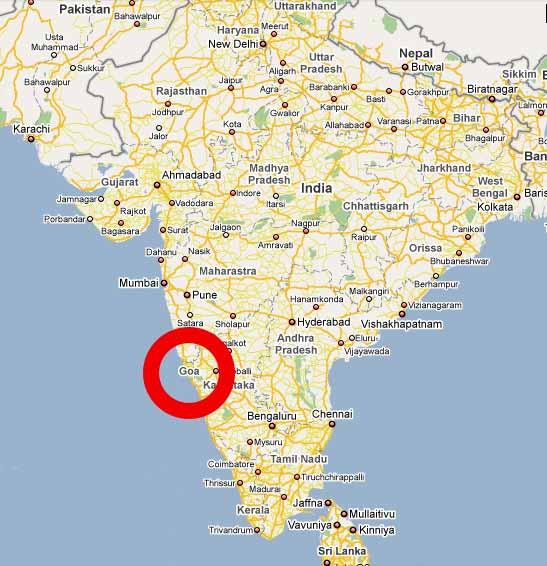 Goa is circled in red.
Goa is circled in red.
That the molasses here is the vinegar.There is 100 pages too much description of what every character wore each time he or she is seen, what is eaten for each meal by our heroes. There are rich descriptions of street scenes, one after another, till they all blend. No doubt life is like that but reading about it should not be. A reader will suppose at the start that somehow it all contributes to the plot but quickly tires of following it all, and then one, well, this one, realised it is window dressing, like sprigs of curly parsley on the plate. Conclusion? Best to skim and turn the pages quickly.
Second in a series but I see no reason to persevere. Too many other good books to read.
Inside this fat book of 400 pages an editor like Elmore Leonard or Stephem King could cut out a good 200 page book that would read itself.
Machiavelli is mentioned. ‘As the philosopher Chanakya, adviser to Mauryan Kings, had declared two thousand years before Machiavelli, the exercise of morality and the exercise of statecraft were separate arts.’ This is a reminder of Richard Christie’s account of the development of MACH IV personality scale which has preoccupied me for some time.
 Paul Mann
Paul Mann
Allan Massie, Death in Bordeaux (2010)
Set in that wine capital in the period May – September 1940 when the world fell in on France.

In April 1940 in far away Bordeaux everyone laughed at the Phoney War and by September 1940 Jews went into hiding, tobacco went into the black market, jackboots were heard everyday and night, and an air of foreboding enveloped one and all. The night creatures emerged, thugs, hooligans, bullies, chancers, and their ilk. Decent people hid away as much as possible.
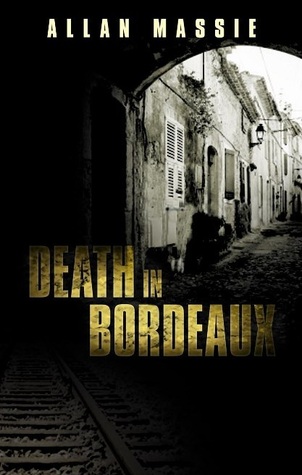
Bordeaux was in Occupied France and as a sea port it was especially occupied to keep people in as much as out, but it was administered by the French government that took up residence in Vichy.
The longstanding practice of posting newly promoted police officers away from home, the better to ensure their impartiality, meant that the Police Judiciare in Bordeaux had Alsatians who are half-German and half-French. Aside: The movement of the border in Alsace meant that in World War I Robert Schumann, later a French foreign minister, was conscripted into the German army and in World War II the French army, experiences that made him a life long proponent of European union. Back to the story.
The Gendarmes find a mutilated body and Inspector Jean Lannes arrives to investigate. There are too few threads to follow, and then too many. Political interference adds to the complications. Those problems fade into insignificance with the Defeat and the Capitulation in June 1940 and the subsequent arrival of the Germans. Yet Lannes continues to probe and push. His offsider Moncerre is a pit-bull on a chain, and Lannes has to restrain him at time. ‘Not now, Mon Brave. Our time will come. Be patient.’
This is the first of a trilogy and the case remains open at the end. The book is well written and includes Lannes’s home life, his fears for his children, his wife’s perseverance in the face of the unknown, the mixed attitudes of the Alsatians, the plight of Jews, the Stoicism of many, and the naked opportunism of others .…. All rendered in clear prose.
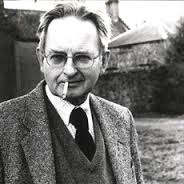 Allan Massie
Allan Massie
Though it perhaps lacks the stifling atmosphere, and mastery of period detail, that Robert Janes conjures in the same period, it is much easier to read and follow than Janes’s cryptic prose, fractured syntax, and loose grammar.
I particularly liked Lannes instinctive response when on an official visit to Vichy he saw Maréchal Pétain walking in a public garden: Verdun. Respect. Salute. One old soldier pays tribute to another. Lannes has no taste for collaboration and sees no honour in defeat, but Pétain has more claim to respect than so many others.
Pedant’s note. The Vichy regime had administrative responsibility for the whole of France including the Occupied Zone and Paris. The reality of that attenuated with time and tide, but in the first days it was real.
Hitler’s New Order of Europe and in parallel Pétain’s National Revolution seemed credible in that time and place. The war was all but over. England would either succumb or make peace to save itself now that it no longer had French allies to die for it. The Third Republic and the French Revolution that it embodied had failed miserably. Time to turn from the past to the future. The young men and women in Lannes’s social, family, and professional circles are confused, dazzled, repelled, and attracted by it all. Will they do something stupid? Dangerous? Almost certainly. But which is more stupid and more dangerous defying the new reality or complying with it?
While there is much to’ing and fro’ing in Bordeaux, street names, cafés, hotels, Spanish Republican refuges, French refuges who arrive just before the Wehrmacht, the two most noteworthy events to happen in Bordeaux in the period the book covers are passed in silence. The first is the Dunkirk evacuation and the second is the arrival of the French government of Paul Reynaud from Paris. Let me explain.
Though distant Dunkirk is mentioned nothing more is said. Yet of the 350,000 soldiers evacuated from the Pas de Calais more than 100,000 were French. The war was still on and upon arrival in England they were put on trains and transported to Bristol, Swansea, and other ports where they were shipped to Bordeaux, on the assumption that the war would go on. All of this was done in a few days. They had no gear or weapons and the chain of command was gone, but they were able-bodied young men with military discipline and combat experience. I am not sure what happened to them in Bordeaux. I expect the malaise of defeat made it impossible for anything constructive to be done. Still the influx of 100,000 men with no shelter, food, etc. would surely have been remarkable.
Second, the Reynaud government declared Paris an open city in the hope that the Germans would not then bomb or shell it. That worked. It went on the road and stopped once or twice along the way before arriving in Bordeaux where it held its last meetings before it dissipated.
‘The Monogram Murders: The new Hercule Poirot Mystery’ (2014) by Sophie Hannah
First things first, Agatha Christie is the Nile River of murder mysteries. Her flood of stories has enriched the soil for others, imitators, rivals, critics, competitors, parodists, and those who try their own hand. Miss Marple, Tommy and Tuppence, and most of all, the one and the only Hercule Poirot.
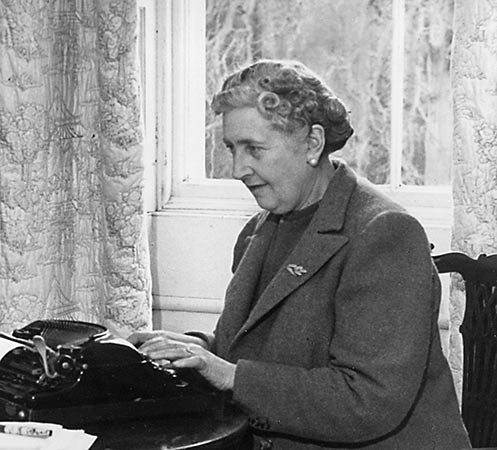 Agatha Christie, who said the secret to getting ahead is getting started. Amen!
Agatha Christie, who said the secret to getting ahead is getting started. Amen!
Poirot revivus! He died in ‘Curtin’ published in 1975 but written thirty (30) years earlier and cached.
The Christie family has guarded her heritage with care. No cheap knock-offs, no tee-shirts, or coffee mugs, no theme tours of St Mary Mead.
Only occasionally have the Christies permitted films based on the novels, and according to the scuttlebutt amongst us krimieologists, the family has not been pleased by some of the movies. Ergo the exacting standards the Christies asserted for the Davis Suchet television series, and we viewers are grateful for the meticulous attention to every last detail, which is just what Poirot himself would do. As he says in this tribute volume, no detail is too small to be important. Only when seen in the proper context can the importance of a detail be determined. Order and method, that is the Poirot way.
This title is a Christie-inheritors approved work that is set in the London of 1928. There is neither war nor depression, yet. Money flow freely.
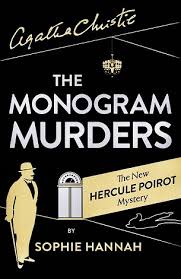
This Poirot is certainly Poirot. He is meticulous, scrupulous, fastidious, observant, perspecatious, easily irked and rather irksome himself. The little mustachios seem to twitch at times. The grey cells are evoked. But more important is the inner man who is compassionate and who detests the evil we do to each other without quite detesting the evildoer, or at least not in all cases.
Each character is well etched and distinguished, though I missed Captain Hastings, here replaced by a fledging police officer name Catchpool. Fee in the coffee shop is a winner and I am sure most readers want to hear more from her. Even Poirot is moved to remark on both her powers of observation and grasp of context, if lacking his unrivalled mastery, as he avers.
There is much to like in the book. If I have to make a criticism I would say that I found the repetitive dialogue as each character tells the story, and some of them tell it twice, and Poirot re-tells it again and again, tedious. We need more movement and activity. The author seems, however, to prefer talk, talk, talk, and more talk. All too much like a David Mamet play where the characters talk each other to distraction and the audience to sleep.
The plot, of course, is convoluted but that is to be expected, though why anyone would try to outsmart Hercule defies belief. Does not everyone know by now that he is world’s greatest detective and is never ever wrong! He certainly does his part to spread the word. However, the plot did not quite deliver the goods. There was a lot more trip than arrival, despite the many repetitions. Perhaps that is a quibble. But the monogram seems to have been there just to confuse things at the beginning, and some of Poirot’s revelations would have been trumped by police post-mortems if the wet-behind-the-ears Catchpool had followed procedure as per many other Agatha Christie stories.
Blue herrings there were a few, and some were never resolved on my reading. Rafal and that laundry cart in the front lobby is made much of when it occurs and referred to again at least once as a lead, and then never mentioned again though Rafal reappears. What did I miss? The hotel manager is such a larger than life character for the first half of the book and then all but disappears. When a character is given so much attention, the reader concludes that the character figures in the plot and is not just wallpaper.
There is an accompanying web site with some mini-videos of the books characters and episodes. Although the ones I watched did not jibe with the novel, so I stopped.
Overall, it is very good to see that Hercule Poirot is back among the crimefighters. Thanks to all involved in the resuscitation.
 Sophie Hannah
Sophie Hannah
Sophie Hannah has a long list of titles and I will certainly make a note to try one of them.
Georges Simenon, ‘The Two-Penny Bar’ (1932)
Maigret did not leap full grown from Simenon’s brow, as Athena did from Zeus. No, he developed overtime. This is one of the early titles.
It is high summer and Maigret wanders around, seemingly with few responsibilities. Madame (Louise) Maigret has gone away for the summer to visit her sister in Alsace, and in her absence he haunts restaurants and bars, and falls in with the crowd at the ‘Two-Penny Bar’ along the Seine in the Ile de France. When a crime occurs under his nose, he muses quite a bit and asks a few questions, but keeps drinking with the crowd, whose members do not seem to mind having a police officer in their midst.
His rapport with the English ex-patriot James is engaging. James keeps popping up and it is evident that he is part of the plot, despite his detached manner.
The sketches of summer heat and blinding light along the Seine make a reader feel warm.
Madame Maigret is, as ever, patient, and long-suffering in silence.
The published title in 1932 as ‘La Guinguette à deux sous’, it was translated into an English edition years ago as ‘The Bar on the Seine.’ A ‘guinguette’ is a small, rustic bar with music and dancing, often to be found in the countryside. Perhaps the equivalent English term is a tavern – nothing fancy and not much in the way of food. ‘Roadhouse’ might also apply.
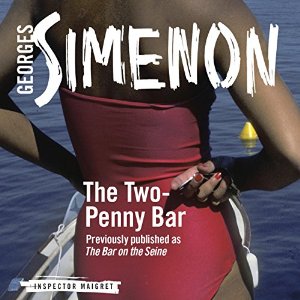
In the French ‘deux sous’: one ‘sou’ + one ‘sou’ = two sous.’ There were 100 ‘sous’ in a franc in those days. A ‘sou’ bought very little, even in 1932. Hence the idiom, not worth a sou (‘ne vault pas un sou’).
For reasons best known to the translator, and I suspect even better known to the publisher, it has been rendered as ‘two-penny.’ Yet later we read of francs. How many pennies to a franc, one wonders.
‘Two-penny’ is not an English idiom, per my web investigation. It seems to be idiosyncratic, fabricated for this title. That is bound to communicate to the reader, eh!
Why do I emphasise this usage by devoting space to it? Because the justification proudly displayed on the Penguin web site for these new translations of the Maigret books that it is marketing is to offer more literal, more authentic translations closer to the original. We can be pretty sure no one along the Seine in 1932 was paying with pennies. One may also wonder about the business sense of deprecating one’s own previous products, too, because after all Penguin editors commissioned and published those earlier translations. If they were as bad as now claimed, does that not undermine confidence in the present crop? Well it does when pennies go into francs. What will future editors at Penguin say about these translations?
I am equally dubious about the woman’s bathing suit that graces the cover of the copy I have. I rather doubt it was worn in 1932. Most swim-ware at the time would have been made of wool, I suspect, and have likely been more modest than the red number on the cover. ‘Fuzzylizzie swimwear’ confirms my hunch.
‘Flykiller’ (2002) by J. Robert Janes
A krimie set in the heart of Vichy administration in February 1943, a bitter winter in a France without coal, food, oil, wool, or much else. Having just read Robert Paxton’s study ‘Vichy France 1940-1944’ I thought to re-read this title which features some of the historical characters mixed with imagination.

This is the an entry in a long running series featuring Jean-Louis St-Cyr of the Sûreté Nationale and Hermann Köhler of the Geheime Staatspolizei, Gestapo. This odd couple are assigned the most sensitive investigations by either German Occupation or Vichy authorities throughout France after the Defeat (16 June 1940).
It was a France dismembered and divided. Germany annexed Alsace and made Lorraine a special administrative unit an inch short of annexation. The coal and steel producing Nord around Lille was administered from Brussels by Germans. Italians occupied Nice, Corsica, and the Savoy. Finally there was Zone Occupée, the north and west coasts defined as operational areas. Each one of these divisions and dismemberments produced a boundary with checkpoints and rules of exclusion.
That occupation broke the chain of command that had held previously in nearly all of its far-flung colonies and throughout much of the French armed forces, but when the Germans disarmed and dismissed Vichy’s Armistice Army in November 1942, the chain of command broke for military men, too. Many of them now felt free to follow their personal convictions and joined France Libre, especially those in North Africa who had ready access.
To illustrate the internal border controls mentioned above, only 250 letters a day were allowed to pass from the Zone Libre (Vichy) to the Zone Occupée. That is a post of 250 between 40 million people! So strictly was the border between Vichy and Occupied France imposed that even Maréchel Pétain was not permitted to cross it to enter Paris for years. No mail at all was allowed to some amputated parts like Alsace.
By February 1943 the Vichy Regime no longer had a purpose, at least not a French purpose. The Germans continued the fiction because even this hand-puppet government retained enough legitimacy to keep some of the population quiet.
The Vichy establishment had until that November been a Ruritania amid the luxury hotels, the Majestic, Palais, Grand, Prince, and d’Enghien. School desks were set up in the hallways for clerks. Ministerial offices were in suites. Down stairs the thugs from the Garde Mobile provided security, many of them released from pre-war penal sentences.
Prime Minister Laval, the dark prince of Vichy, and President Phillipe Pétain, the figurehead, hated one another. Laval thought Pétain a relic, paralysed by the past, and more interested in breakfast than high politics. Pétain called Laval a peasant, one who blew cigar smoke in his face time and again, preferring as prime minister the austere Darlan or toadying Flandin. Pétain and Laval each plotted the other’s downfall. Laval had traversed the Third Republic, from a Socialist, to a Radical, had been foreign minister, had been prime minister, and came from the Auvergne (Vichy) where he owned a newspaper and radio station. Laval’s powers of self-delusion were so great that he continued to believe in the final victory of German even late in 1944 when most of France had been liberated by the Allies.
It is this same Laval who asks for the service of St-Cyr and Köhler when a young woman is found stabbed to death in the foyer of the long-closed Hall des Sources, the hot springs. This sybarite kingdom was closed in June 1940 and stayed closed since. When St-Cy and Köhler arrive, at 2 a.m., having been summoned from elsewhere, the heat has been off in the Hall for two years and it is freezing outside, yet the hot springs beneath impart warmth to parts of the building, steam vents from pipes broken and not repaired, wherein there is no electricity. As they move about with lanterns, the building seems to breath and even move when images are reflected in the many mirrors , frosted windows, and dull but polished surfaces. Very nicely done.
 One such spa
One such spa
St-Cyr has an empathy that allows him nearly to communicate with the dead. He studies the corpse, ear rings, clothing, shoes, feet, hands trying to infer the events the that brought the victim through the snow outside to her death in the locked and abandoned building. Köhler takes a more empirical approach, looking for a lost earring, a boot mark on the base of a counter, recent chip in a beveled edge. The two detectives combine the metaphysical and physical worlds.
Each man served in World War I at Verdun where each was wounded. Both now in the 50s both are too old for military service. Each has been a policing since 1919, and they first met at a police congress in Vienna twenty plus years before. When Köhler was made a one-man flying squad for France, he asked for a French offsider and asked for St-Cyr by name. St-Cyr learned German with his Alsatian relatives, while Köhler learned French in a prisoner of war camp.
Köhler is not a loyal Nazi, still less now that both his sons were killed on the Russian front and his wife left him in the aftermath. St-Cyr sees in Vichy elite many of the embezzlers, opportunists, thugs, and chancers he used to jail. That he works with the Germans, makes him a collabo to many Frenchmen. His wife and child were killed in a bomb blast perhaps meant for him by one of the many factions of the Resistance. ‘Collabo’ is collaborator.
The most venomous French collaborators were the intellectuals in Paris, not the officials and bureaucrats in Vichy, apart from the very top ranks. The collabo Parisienne intellectuals, journalists, academics poured venom on Vichy for its trepidation, its hesitations, its half-hearted pursuit of Jews, its failure to seek out spies in its midst, and so on and on. No exaggeration was enough. No cause too trivial to unleash a torrent of bile. Whoops! Starting to sound like Fox News or The Australian newspaper.
What does the title ‘Flykiller’ mean? Good question! Go to the head of the class. That very question is asked in the book, but not answered. ‘Tue-mouches’ is a code name used by Prime Minister Pierre Laval. In an end note it seems ‘Tue-mouches’ was the code name for Jean Schellnenberger, arrested, tortured, and shot by the Milice in Dijon in 1942.
It is a complicated story with wheels within wheels and more, but finally satisfying. Many blue herrings are followed. A gallery of innocent and guilty ones are reviewed to find the culprit, the Flykiller. The period and place details is credible as is the language. But having said that Jane taxes the reader a lot by seldom clearly signaling who is speaking. Worse since much is thought and not said, in this time when words killed, it is sometimes not clear whose thoughts are on the page. I do wish he learned it write ‘St-Cyr thought’ or ‘Hermann said.’ It would speed my reading and comprehension.
J. Robert Janes
There are a dozen more titles in the series.
Warning! Tangent ahead:
Henri-Georges Clouzot’s (1907-1977) film ‘Le Corbeau’ (1942) is a subtle critique of life in Vichy France made for the German film company Continental in France, and passed by both the German and Vichy censors for national distribution.
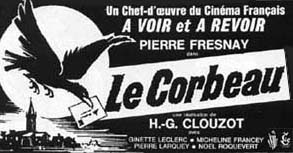 Lobby card when the film was re-discovered
Lobby card when the film was re-discovered
The ironies of life are these. In the early 1930s Clouzot worked in Germany for Continental making French version of German films. He was dismissed because he mixed with Jews and spoke against their exclusion from the film industry. He went back to France where he found getting work hard because he was perceived to be a friend of Germany. During the Occupation he found work again with the French branch of Continental making ‘Le Corbeau’ which caused him to be banned from film work from 1945-1947 because the film vilified the French. Upon release the film had been denounced by Vichy reviewers, by reviewers in Resistance newspapers, and by German reviewers, who had it withdrawn.

Henri-Georges Clouzot
He managed to offend everyone in this simple story. Doh! Clouzot’s had tuberculous and, perhaps, had not the strength to explain or defend himself, nor perhaps the inclination. When the ban was lifted he made some memorable films like ‘Quai des Orfèvres’ (1947), ‘Le salaire de peur’ (1953), ‘Les Diaboliques’ (1955). and ‘La Vérité (1960). None of these films fits neatly into a category and so he again irritated reviewers one and all. ‘Quai des Orfèvres’ is a police procedural which is also a study of life in a broken and impoverished France. It does not glorify the police officer nor condemn the villains but treats each as a fact of nature like a thunderstorm. ‘Le salaire de peur’ is an exposition of the nihilism of existential philosophy at a time when most film reviewers were in love with it. ‘Les Diaboliques’, well, these were liberated women without the rhetoric. ‘La Vérité’ is a critique of social hypocrisy among the very people who attend such films. Then there was ‘L’Enfer’, unfinished, a study of obsession though there is a documentary film about it called ‘Henri-Georges Clouzot’s “l’Enfer.”‘ Another Vichy film is ‘L’assassin habit au 21’ (1942) which reduces Vichy to a single rooming house in which one resident is a murderer but which one? It is played as a parody of the murder mystery and so was passed by censors but it irritated reviewers for its failure to conform to stereotypes.
‘Softly dust the corpse’ (1960) by S. H. Courtier. Recommended
A fine krimie by an Australian writer, this and his other books too long out of print. This one was originally published in London as ‘Gently dust the corpse.’ Why it was changed from ‘Gently’ to ‘Softly’ is anyone’s guess.

It offers the classic setup of an group people isolated from the outside world with tensions among them, in this case at Tyson’s Bend on the Old(est) Hume Highway between Melbourne and Sydney near Mildura in the 1950s. The tensions spring from a missing lottery ticket worth £100,000. So far so ordinary.
Tyson’s Bend has a petrol pump, a general store, a pub, a school, and perhaps a population of 200.
What sets this work apart is the additional character of the dust storm that cuts cuts off Tyson’s Bend from the outside world, making driving impossible and bringing down telephone wires. While most of the townfolk shelter at home about a dozen take refuge in the pub where, thanks to a generator, the beer remains cold. These people are the syndicate that bought the lottery ticket which has won, but before they can collect the dust storm hits, hits hard, and keeps hitting.
The wind howls and cracks, the dust is invidious and insidious, getting through every crack, slit, hole, and into everything from eyes to drinks. It just goes on and on, shaking the roof, ripping doors open, cracking windows, overturning cars, blowing detritus with force, making a walk from one house to another as dangerous and difficult as such a walk in an Antarctic winter. Even in the pub, dust swirls in the air and coats and re-coats every surface. Makeshift face masks and dark glasses are essential to venturing outside and they add to the mystery.
 The dust of the Red Centre
The dust of the Red Centre
The dust clogs and carpets everything from eye brows to clothing. There is no escape and no relief from it. It is like a bombardment without end. The setting is marvellous and far more dramatic than comparable efforts by the dean of Australian krimie writers, Arthur Upfield. The storm is a malevolent force even greater than the murderer within the ranks, and far more destructive.
 A dust storms envelops Melbourne
A dust storms envelops Melbourne
The characters are well defined; The nervous school teacher, the bullying policeman and his subdued wife, the simple store owner whose clever wife runs most things in town, the barman who plays the clown, the jackaroo who keeps to himself, and the two city lawyers who are trapped there. It seems one member of the syndicate is determined to murder the other members to get the lottery ticket!
I learned a new word ‘bombilation’ (p. 180) which is very old and means to buzz. Here it refers to the incessant noise of the storm.
 S. H. Courtier, school teacher by day
S. H. Courtier, school teacher by day
I read several other of Sidney Courtier’s books in the 1970s and liked them. There a great many others, though out of print, and so not easy to come by. There is a good entry for Sidney Hobson COURTIER at AustcrimeFiction.org
